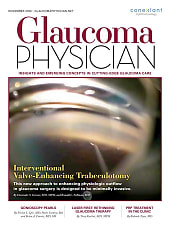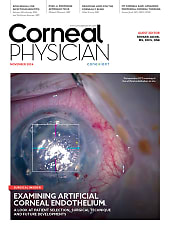"He who does not operate, experiences no postoperative complications."
CASE PRESENTATION
A 60-year-old female patient presented with a 2-week history of inferior visual field loss in the left eye. She had 20/20 vision OU on presentation, and was diagnosed with a macula-on retinal detachment with giant retinal tear of the left eye.
The retinal detachment was repaired with scleral buckle placement and pars plana vitrectomy using perfluoro octane gas (PFO), air fluid exchange, 360-degree endolaser, and placement of 14% C3F8 gas. The patient had a normal postoperative presentation until 8 weeks post-op, when she started to complain of severe headaches that progressed to vision loss in the fellow (right) eye. At this point, anterior chamber inflammation and vitritis became visible in both eyes, with small pockets of submacular fluid collections and choroidal lesions seen on fluorescein angiography (Figure 1). Her vision had dropped to 20/100 in the right eye and 20/200 left eye.

DIAGNOSIS
While the differential includes conditions such as Vogt-Koyanagi Harada disease, sarcoidosis, syphilis, lymphoma, and paraneoplastic diseases, a diagnosis of postoperative sympathetic ophthalmia (SO) was made given the acute postoperative presentation.
The patient had a full workup to rule out infectious etiology, and was started on high-dose oral methylprednisolone (60 mg daily). She was consulted to the University Hospital Uveitis and Rheumatology services for comanagement of her disease.
A steroid-sparing agent (mycophenolate mofetil 1.5 grams PO b.i.d.) was initiated.
DISCUSSION
SO is a rare bilateral diffuse granulomatous, non-necrotizing panuveitis which classically occurs after ocular trauma. Surgery has become the most common cause of SO, and pars plana vitrectomy has the highest incidence amongst the ophthalmic surgeries (0.12%).
The disease generally consists of an exciting eye and a sympathizing eye. Inflammation generally occurs within the first 3 months of surgery in more than 80% of cases.
The severity of inflammation can vary. Anterior segment findings include mutton-fat keratic precipitates, thickening of the iris, and posterior synechiae. Posterior segment findings consist of vitritis, Dalen Fuchs nodules, peripapillary choroidal lesions, and exudative retinal detachment. Early in the disease, a fluorescein angiogram will typically show multiple areas of punctate hyperfluorescence (starry sky) with leakage and pooling at areas of neurosensory detachment of the retina. ICG will demonstrate multiple areas of hypofluorescent foci; and on OCT, serous retinal detachments with intraretinal edema will be evident. Choroidal thickening can also be detected on B-scan.
Treatment classically consists of enucleation in the case of an unsalvageable traumatized eye to prevent SO of the fellow eye. However, in all other cases, timely administration of high-dose systemic steroids with extended therapy using a steroid-sparing agent can result in a good visual prognosis.
OUTCOMES
Seven weeks after initiating treatment, our patient had regained 20/20 vision in the right eye and 20/60 vision in the left eye. All intraocular inflammation and macular fluid had completely resolved. The patient was successfully weaned off of methylprednisolone, and continues on same dose mycophenolate mofetil.
She ultimately required cataract surgery for the left eye and a YAG capsulotomy. She also developed cystoid macular edema (CME) in the left eye, which required a posterior sub-Tenon’s Kenalog injection. Final acuity achieved was 20/20 vision in the left eye. She continues to do well 2 years after her surgery. NRP








